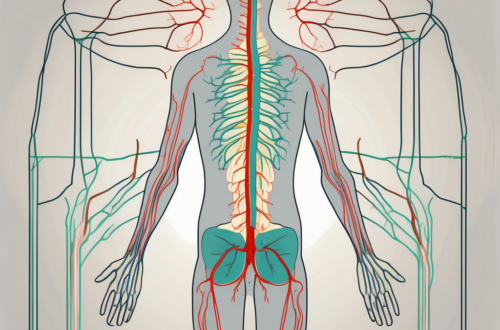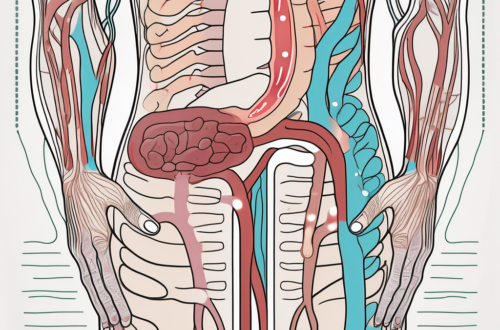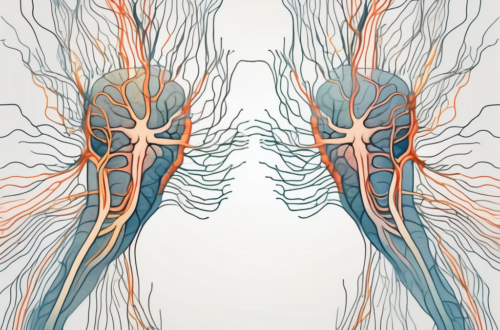The human body is a complex and intricate system, with numerous nerves and pathways that are responsible for ensuring proper functioning of various bodily processes. Among these nerves, the parasympathetic nerve and the maxillary nerve play vital roles. In this comprehensive guide, we will delve into the intricacies of these nerves and explore their connection. It is important to note that while this article provides valuable information, it is not a substitute for professional medical advice, and readers are encouraged to consult with a healthcare professional for any specific questions or concerns.
Understanding the Parasympathetic Nervous System
Before we explore the parasympathetic nerve and its connection with the maxillary nerve, it is important to have a solid understanding of the parasympathetic nervous system itself. The parasympathetic nervous system is one of the three divisions of the autonomic nervous system, alongside the sympathetic and enteric nervous systems. Its main role is to promote rest, relaxation, and digestion, counterbalancing the sympathetic nervous system’s fight-or-flight response. Through its intricate network of fibers and ganglia, the parasympathetic nervous system regulates various bodily functions such as heart rate, digestion, and glandular secretions.
While the sympathetic and parasympathetic nervous systems often work in opposition, they ultimately collaborate to maintain a delicate balance within the body. Understanding the parasympathetic nervous system is crucial in comprehending its relationship with the maxillary nerve.
The Role of the Parasympathetic Nervous System
The parasympathetic nervous system is primarily responsible for conserving energy and enhancing bodily functions during periods of rest and relaxation. It works to maintain homeostasis by stimulating activities such as digestion, urination, defecation, and salivation. The parasympathetic nerve fibers originate from specific regions of the brain, including the brainstem and the sacral spinal cord, and extend to various targets within the body.
One crucial aspect of the parasympathetic nervous system is its ability to induce a state of calmness and relaxation. When activated, it helps to decrease heart rate, constrict bronchial tubes, and enhance digestion processes. Additionally, it plays a vital role in the regulation of sexual function and reproductive processes. The parasympathetic nervous system’s involvement in these essential bodily functions underscores its significance in maintaining overall health and well-being.
Key Components of the Parasympathetic Nervous System
To better understand the parasympathetic nervous system, it is essential to examine its key components. The main components of the parasympathetic nervous system include the cranial nerves and the sacral nerves.
The cranial nerves, which originate in the brainstem, play a pivotal role in the parasympathetic innervation of various organs and structures within the head and neck region. Of particular interest in our discussion is the cranial nerve known as the oculomotor nerve, which has direct connections with the maxillary nerve. This connection highlights the deep interplay between the parasympathetic and maxillary nerves, underscoring their importance in the functioning of the head and face regions.
Additionally, the sacral nerves, originating from the sacral spinal cord, contribute to the parasympathetic innervation of the lower abdominal and pelvic regions. These nerves innervate the bladder, uterus, and reproductive organs, demonstrating the parasympathetic nervous system’s involvement in these vital functions.
The parasympathetic nervous system also interacts with various other systems and structures in the body. For example, it has connections with the lacrimal glands, which produce tears to keep the eyes moist and protected. The parasympathetic fibers stimulate the production of tears, ensuring proper lubrication and preventing dryness or irritation.
Furthermore, the parasympathetic nervous system plays a role in the regulation of blood flow. It helps to dilate blood vessels in certain areas, allowing for increased blood supply to specific organs and tissues. This increased blood flow ensures optimal functioning and nourishment of these structures.
In addition to its direct effects on bodily functions, the parasympathetic nervous system also has indirect influences on mental and emotional well-being. When activated, it promotes a sense of relaxation and tranquility, reducing feelings of anxiety and stress. This calming effect can have a significant impact on overall mental health and contribute to a sense of overall well-being.
Overall, the parasympathetic nervous system is a complex and vital component of the autonomic nervous system. Its intricate network of fibers and connections allows for the regulation of various bodily functions, ensuring optimal health and functioning. Understanding the parasympathetic nervous system and its relationship with the maxillary nerve provides valuable insights into the intricate workings of the human body.
The Maxillary Nerve: An Overview
Now that we have gained insight into the parasympathetic nervous system, we can shift our focus to the maxillary nerve and its role in the broader neural network. The maxillary nerve is a branch of the trigeminal nerve, which is the largest cranial nerve and responsible for sensory input from the face. The trigeminal nerve has three major branches: the ophthalmic, maxillary, and mandibular nerves.
The maxillary nerve is the second branch of the trigeminal nerve and is primarily responsible for sensory innervation of the middle third of the face. It extends from the skull base through the foramen rotundum, passing through various structures within the face to provide sensory perception. Understanding the anatomy and functions of the maxillary nerve is vital for comprehending its connection with the parasympathetic nerve.
Anatomy of the Maxillary Nerve
The maxillary nerve traverses a complex pathway within the facial region, originating in the trigeminal ganglion. From there, it enters the skull base through the foramen rotundum and passes through the pterygopalatine fossa. Within this fossa, the maxillary nerve gives rise to numerous branches responsible for innervating different facial structures, including the upper teeth, gingiva, nasal cavity, and palate.
As it continues its course, the maxillary nerve provides sensory innervation to the skin overlying the maxilla, the cheek, and the side of the nose. It also supplies sensory information to the maxillary sinus and contributes to the sensation within the upper lip.
The maxillary nerve’s intricate pathway allows it to reach various regions of the face, ensuring comprehensive sensory innervation. The branches that originate from the maxillary nerve play a crucial role in transmitting sensory information from specific facial structures, allowing for precise perception and response.
Functions of the Maxillary Nerve
The maxillary nerve plays a crucial role in mediating sensory feedback from the middle third of the face. It allows individuals to perceive various sensations, including touch, temperature, and pain, in the innervated areas. Additionally, the maxillary nerve is involved in the process of transmitting proprioceptive information, which aids in the perception of spatial orientation and movement of facial structures.
Furthermore, the maxillary nerve contributes to the regulation of blood flow in the face, ensuring optimal circulation to maintain tissue health. It also plays a role in the secretion of tears and saliva, facilitating proper lubrication and moisture in the oral and ocular regions.
Understanding the sensory functions facilitated by the maxillary nerve is essential in appreciating its relationship with the parasympathetic nerve. The convergence of these two nerves paves the way for a deeper understanding of their interconnected roles in maintaining overall health and function.
In summary, the maxillary nerve is a vital component of the trigeminal nerve and is responsible for sensory innervation of the middle third of the face. Its complex pathway and numerous branches ensure comprehensive sensory perception in various facial structures. The maxillary nerve’s functions include mediating touch, temperature, and pain sensations, transmitting proprioceptive information, regulating blood flow, and facilitating tear and saliva secretion. Understanding the intricate anatomy and functions of the maxillary nerve enhances our comprehension of its connection with the parasympathetic nerve and its overall role in maintaining optimal health and function.
The Parasympathetic Nerve and Its Connection with the Maxillary Nerve
Having explored the parasympathetic nervous system and the maxillary nerve individually, we can now examine their connection and the implications it holds for human health. The parasympathetic nerve, often referred to as the cranial parasympathetic outflow, has direct links with the maxillary nerve. Understanding the pathway of the parasympathetic nerve and its interaction with the maxillary nerve sheds light on the complexity of their relationship.
The Pathway of the Parasympathetic Nerve
The parasympathetic nerve fibers that interact with the maxillary nerve originate from the facial nucleus, which is located within the brainstem. These fibers exit the brainstem at the level of the pons and then join the facial nerve, blending with its branches. It is at this juncture that the connection with the maxillary nerve occurs, as the parasympathetic fibers travel with the sensory fibers of the maxillary nerve.
As the parasympathetic fibers continue their journey, they eventually form a structure called the pterygopalatine ganglion, also known as the sphenopalatine ganglion. This ganglion lies in close proximity to the maxillary nerve as it passes through the pterygopalatine fossa. The pterygopalatine ganglion is responsible for relaying parasympathetic stimulation to various structures, including the lacrimal gland within the orbit, the nasal glands, and the mucous membranes of the nasal cavity.
The intricate pathway of the parasympathetic nerve and its connection with the maxillary nerve showcases the remarkable complexity of the human nervous system. This connection allows for the coordination and regulation of various physiological processes, ensuring the optimal functioning of the sensory and secretory systems in the middle third of the face.
The Interaction between the Parasympathetic and Maxillary Nerves
The connection between the parasympathetic and maxillary nerves highlights the intricate interplay between different neural components within the human body. As the parasympathetic fibers travel with the maxillary nerve, they have the potential to modulate the sensory perception of the middle third of the face. This connection also underscores the influence of the parasympathetic nervous system in the regulation of tear production, nasal secretions, and the general well-being of the nasal cavity.
Furthermore, this interaction has implications beyond sensory perception. The modulation of the maxillary nerve by the parasympathetic system can play a role in various health conditions and medical procedures. For example, in patients with chronic rhinosinusitis, a condition characterized by inflammation of the nasal and sinus cavities, the parasympathetic innervation of the maxillary nerve may contribute to the excessive production of nasal secretions. Understanding these implications allows for a more thorough exploration of potential health issues and the importance of this connection in medical interventions.
Moreover, the parasympathetic innervation of the maxillary nerve is also relevant in dental procedures. Dentists often administer local anesthesia to numb the maxillary teeth and surrounding tissues. By targeting the maxillary nerve, dentists can effectively block the transmission of pain signals. However, it is important for dentists to consider the potential impact of parasympathetic stimulation on tear production and nasal secretions during these procedures.
In conclusion, the connection between the parasympathetic nerve and the maxillary nerve is a fascinating aspect of human anatomy and physiology. It showcases the intricate pathways and interdependencies within the nervous system, while also highlighting the potential implications for sensory perception, tear production, nasal secretions, and various medical interventions. Further research in this field will undoubtedly contribute to a deeper understanding of the human body and its complex mechanisms.
Implications of Parasympathetic and Maxillary Nerve Interactions
The interaction between the parasympathetic nerve and the maxillary nerve has far-reaching implications in the realm of human health and medical procedures. While it is important to note that individual cases may vary, this section highlights some potential health issues that can arise as a result of these interactions, as well as the importance of this connection in certain medical procedures.
Potential Health Issues
One potential health issue related to the parasympathetic and maxillary nerve interaction is trigeminal neuralgia. Trigeminal neuralgia is characterized by intense facial pain that can be triggered by even mild stimuli, such as talking, chewing, or touching the face. The parasympathetic fibers interacting with the maxillary nerve may exacerbate the pain experienced by individuals with trigeminal neuralgia. It is important for those affected to consult with a healthcare professional to explore appropriate treatment options.
In addition to trigeminal neuralgia, the parasympathetic and maxillary nerve interaction can also have implications for other health conditions. For example, disruptions in the innervation of the lacrimal gland by the parasympathetic fibers may contribute to dry eye syndrome. Individuals with this condition often experience discomfort, a gritty sensation, and a decline in tear production. By understanding the intricate connection between the parasympathetic and maxillary nerve, healthcare professionals can better identify potential causes and formulate suitable treatment strategies for this condition.
Furthermore, the parasympathetic and maxillary nerve interaction may play a role in the development and progression of certain dental and oral health issues. For instance, the interaction between these nerves can influence the blood supply and innervation of the teeth and surrounding tissues in the upper jaw. Any disruptions in this interaction may contribute to dental problems such as tooth sensitivity, gum disease, or even tooth loss. Dental professionals can leverage their understanding of this connection to provide appropriate treatment and preventive measures to maintain optimal oral health.
Importance in Medical Procedures
The parasympathetic and maxillary nerve connection also holds importance in certain medical procedures. One such procedure is maxillary nerve block, a technique employed for various dental and facial surgeries. In this procedure, an anesthetic agent is administered to temporarily block the maxillary nerve, thereby preventing pain perception during the surgical intervention. Understanding the complex innervation of the maxillary nerve, including its association with parasympathetic fibers, is essential for performing this procedure effectively and safely.
Additionally, the parasympathetic and maxillary nerve connection plays a crucial role in dental treatments and interventions involving the maxilla and teeth in the upper jaw. Dentists and oral surgeons leverage this connection to deliver appropriate anesthesia and manage pain during procedures in this region, ensuring patient comfort and optimal outcomes. By carefully considering the interaction between these nerves, healthcare professionals can tailor their approach to each patient, providing personalized care and minimizing discomfort.
In conclusion, the interaction between the parasympathetic nerve and the maxillary nerve has significant implications in various aspects of human health and medical procedures. From potential health issues such as trigeminal neuralgia and dry eye syndrome to the importance of this connection in dental treatments and maxillary nerve blocks, understanding and considering this intricate relationship is essential for healthcare professionals to provide effective and comprehensive care to their patients.
Future Research Directions in Parasympathetic and Maxillary Nerve Studies
Advancements in neuroscience and technology continue to expand our understanding of the parasympathetic and maxillary nerve connection. Ongoing research endeavors and emerging technologies are paving the way for potential breakthroughs in the field of neurology. As we look to the future, several research directions offer exciting prospects for further exploring these complex nerves.
Emerging Technologies for Nerve Studies
One area of interest in nerve studies is the development of innovative imaging techniques that allow for precise visualization of the nerves and their connections. Advances in imaging technology, such as 3D reconstruction and high-resolution MRI techniques, offer the potential to better understand the intricate details of the parasympathetic and maxillary nerves. These technologies may reveal previously unknown anatomical variations or shed light on the mechanisms underlying specific conditions.
Additionally, molecular and genetic studies provide further opportunities to unravel the intricate pathways and functions of these nerves. Researchers are exploring the genetic basis of parasympathetic nervous system disorders and investigating potential targets for therapeutic interventions. Insights gained from these studies hold promise for the development of targeted treatments and personalized medicine approaches.
Potential Breakthroughs in Neurology
Neurology as a field is rapidly evolving, and potential breakthroughs related to parasympathetic and maxillary nerves are on the horizon. Understanding the interplay between these nerves and comprehending their intricate connections creates opportunities for developing novel treatment strategies for various health conditions. Additionally, gaining insights into the parasympathetic and maxillary nerves may shed light on broader neural mechanisms and contribute to our understanding of the human nervous system as a whole.
Conclusion
The parasympathetic nerve and the maxillary nerve are both integral components of the human neural network. The parasympathetic nervous system’s role in maintaining rest, relaxation, and digestion, combined with the sensory functions facilitated by the maxillary nerve, underscores their significance in overall health and well-being. Understanding the connection between these nerves provides valuable insights into potential health conditions, as well as the importance of this connection in certain medical procedures. Looking toward the future, ongoing research and emerging technologies offer promising avenues for further exploring and understanding these complex nerves. As the field of neurology continues to advance, our knowledge of the parasympathetic and maxillary nerves will deepen, leading to improved healthcare outcomes and enhanced understanding of the human body.





